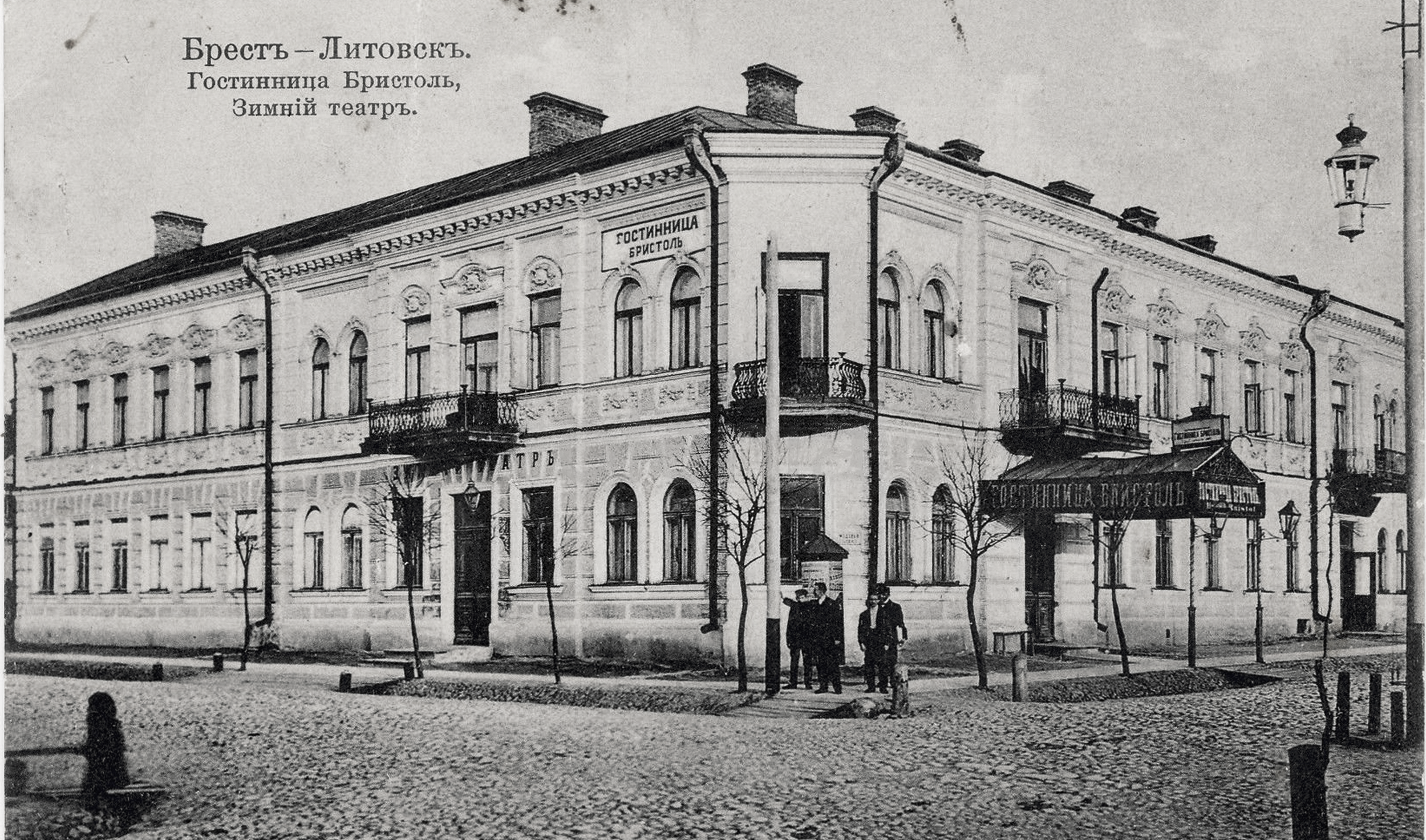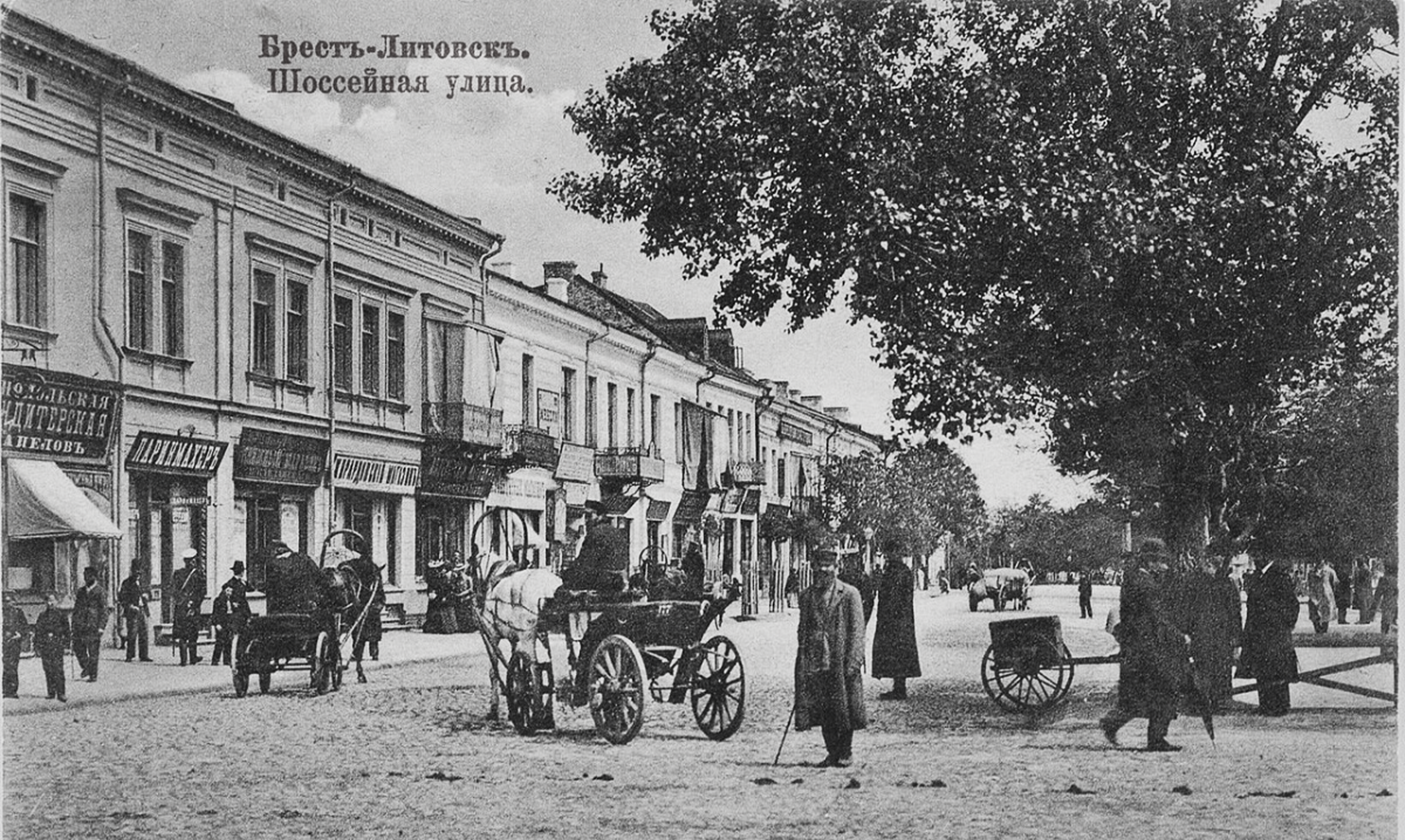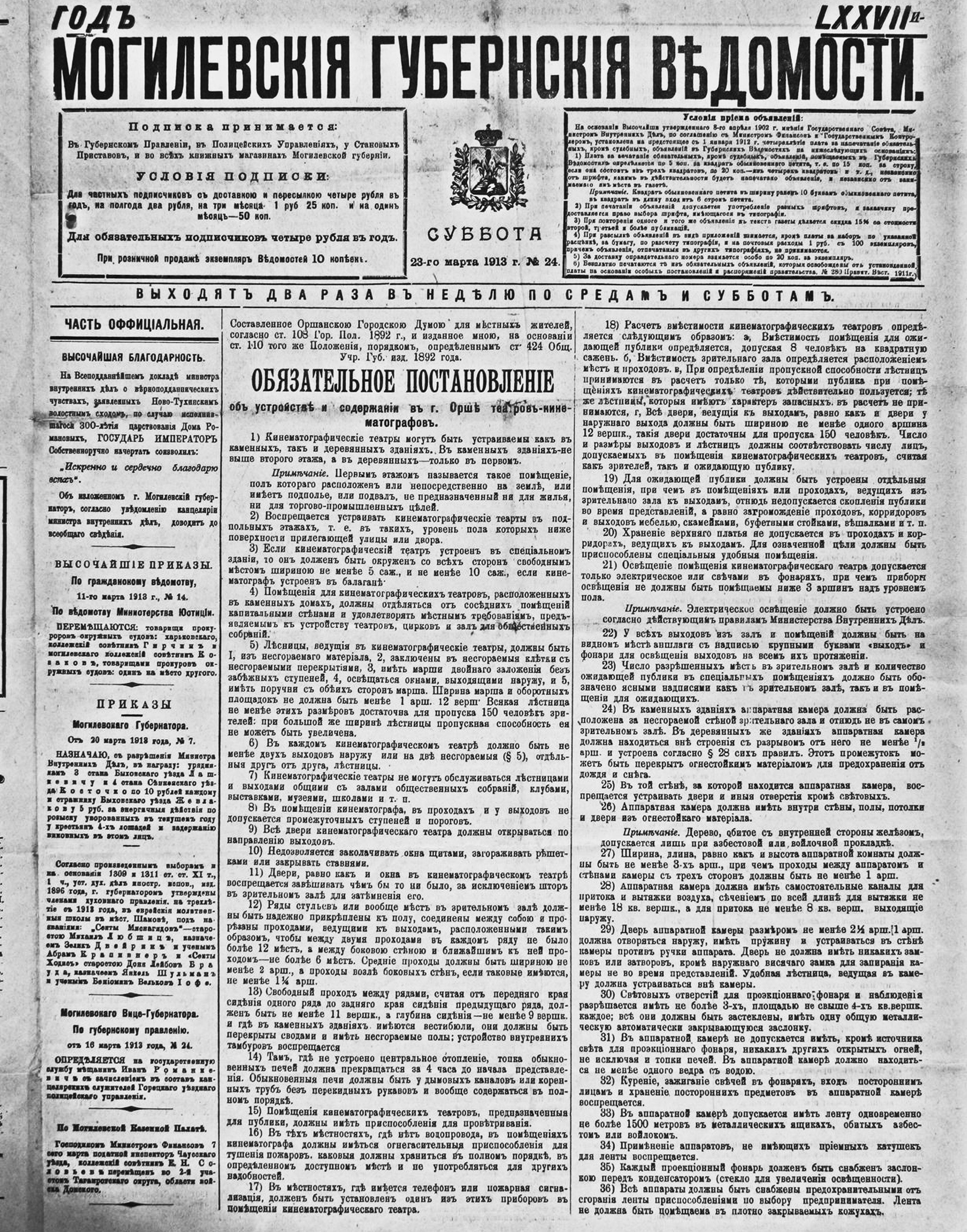A Golden Age of Belarusian Cinemas.
Brest-Litovsk • Orsha
Brest-Litovsk
In June 1911, Cine-Phono reported that there were three theaters in Brest-Litovsk, but that the third, unnamed, theater was “living out the last days of its existence.1 One of the three theaters, the Fantasia was “so small” that it became stuffy in the summer and needed electric fans installed. It was also on the first floor in a building where the second floor was a hotel owned by Rosenblatt, who also owned the theater.2
In November 1911, the Cine-Phono correspondent complained that there was only one cinema in the city. The correspondent asked, “Why has this city sinned?”3 Compare this to 1910, when Kine-Zhurnal wrote that Brest has four theaters, the Illusion, the Fantasia, the Oasis, and the Orion.4 Cine-Phono reported in January 1912, that the Illusion had closed.5
Brest-Litovsk, beginning of the XX century.
Source: www.meshok.ru, Public domain, via Wikimedia Commons, 1903
A year and a half later, by the middle of 1913, there were two theaters in operation. The Fantasia was on Shosseynaya Street and the Lotus was on Pochtovoy Lane. The correspondent wrote that the program at Lotus was more interesting, but the Fantasia had a better location, in the city center. It also did a better job of advertising. There was hope that a third theater, the Excelsior, would open in September, but it did not.6 Apparently, there had been three other theaters in Brest, all of which failed: the Orion, Oasis, and the aforementioned Illusion. Fantasia had stood the test of time, it opened some time in 1907. 7
Brest-Litovsk, Shosseynaya Street, beginning of the XX century.
Source: https://www.realbrest.by/novosti/realnyi-brest/imenuemyi-brestchanami-nevskim-prospektom.html
Orsha
In January 1913, Zlatin and Kichin purchased the Modern from Rymashevsky and converted it into a cinema.8 Later in 1913, Cine-Phono wrote that the “Illusion is the only entertainment institution” in Orsha. The same report said “The theater hall was renovated, electric ventilation was arranged, the foyer was decently cleaned with upholstered red satin furniture and pasted with beautiful wallpaper, so that the theater would produce a good evening,” and that the theater changed pictures 3 times a week.9
This photo is from around 1910, so it may be when the building was still for plays only.
Modern Theater, Orsha, 1910.
Source: https://smolbattle.ru/threads/Орша-путешествие-в-прошлое.51461/
Also in early 1913, authorities published new fire regulations. They came two years after the big fire at Bologoye, but there may have been, and probably were, other regulations in the meantime that we have not found. 10
MANDATORY REGULATION
About the arrangement and maintenance in the city of Orshe Theaters cinematographers.
Cinematographic theaters can be arranged both in stone and wooden buildings, in stone buildings above the second floor, and in wooden buildings only in the first floor.
Presentation. The first floor is called such a room, the floor of which is located! or directly on the ground, or has a basement, or basement, not intended for habitation,nor for commercial and industrial purposes.
It is forbidden to arrange cinematographic theaters in underground floors, i.e. in those whose floor level is lower than the surface of the adjacent street or courtyard.
If the theater is cinematically arranged in a special building, then it must be surrounded on all sides by a free space with a width of at least 5 sazhens, and at least 10 sazhens, if the cinema is arranged in a booth.
For cinematographic theaters located in stone houses, should be separated from the old ones by capital walls and satisfy the local requirements for the arrangement of theaters, circuses and halls for general meetings.
The steps leading cinematographic theatres must be: 1) made of fireproof material, 2) enclosed in fireproof cells with fireproof ceilings, 3) have double staircases without forgotten steps, 4) be illuminated by windows facing the outside, and 5) have handrails on both sides of the flight. The width of the flight and reversible platforms should not be less than 1 arsh, 12 versh. Any staircase of at least these dimensions is sufficient to accommodate 150 spectators, but with the great width of the staircase, its capacity cannot be increased.
In every cinematographic theater there should be at least two exits outwards or on two fireproof (§ 5), separate from each other, ladders.
Cinematographic theaters cannot be served by stairs and exits common with public halls! clubs, exhibitions, museums, schools, etc.
In the premises of the cinema, in the aisles and at the exits, intermediate steps and thresholds are not allowed.
All doors of the cinematographic theater must open in the direction of the exits.
It is not allowed to board up the windows with shields, block them with bars or close them with shutters.
Doors, as well as rams in cinema! In the theater it is forbidden to hang whatever it is, for the clear curtains in the auditorium! hall for eating.
Rows of chairs or revenge in general in the auditorium must be securely fastened to the floor, connected to each other and cut by passages leading to exits, arranged in such a way, so that between two aisles in each row there is no more than 12 places, and between the side wall and the nearest passage to it, no more than 6 places. The middle passages must be at least 2 arshins wide, and the passages near the side walls, if any, at least 1 1/4 arshins wide.
The free passage between the rows, counting from the front edge of one row to the second edge of the previous row, must be not less than 11 versh., and the depth of the seat must be at least 9 vershes, and where there are vestibules in stone buildings, they must be covered with vaults and have fireproof floors: the construction of internal vestibules is prohibited.
Where there is no central heating, the furnace of ordinary stoves should be turned 4 hours before the start of the presentation. An ordinary stove should be at the chimneys or main chimneys without overhangs and in general should be kept in full order.
The premises of cinematographic theaters intended for the public should be adapted for ventilation.
In those areas where there is no water supply, in the premises of the cinema there must be fire-extinguishing devices adapted for extinguishing fires. which should be kept in full order, in a certain accessible place and not used for other needs.
In areas where there is a telephone or fire alarm, one of these devices should be installed in the premises of the cinematographic theater.
The calculation of the capacity of cinematographic theaters is determined as follows: a) The capacity of the waiting audience is determined by allowing 8 people per square sazhen, b) The capacity of the auditorium is determined by the location of the rooms and passages, c) When determining the capacity of the stairs, only those that the public uses at the premises of cinematographic theaters are taken into account; the same ladders that have the character of reserves. All doors leading to the exits, as well as the doors at the outer exit must be at least one arshin wide 12 arshins, so the doors are sufficient for the passage of 150 people. The number and size of exits and stairs must correspond to the number of persons allowed in the premises of cinematographic theaters, counting both the audience and the waiting audience.
A separate room should be arranged for the waiting audience, where in the rooms or passages leading the auditorium to the exits, crowded people are not allowed during the performances, as well as cluttering the passages, corridors and exits with furniture, benches, pantry counters, hangers, etc.
Keeping the outer dress is not allowed in the aisles and corridors, leading to the exits. For the indicated purpose, special and comfortable places should be adapted.
The lighting of the cinematographic theater is allowed only electric or candles in lanterns, and the instrumentation should not be placed below 3 arshins above the level! lap
Note. Electric lighting should be arranged according to the current Rules of the Ministry of Internal Affairs.At all exits from the hall and the room there should be in a visible place signs with the inscription in large letters "EXIT" and lanterns for illuminated exits along their entire length.
The number of permitted seats in the auditorium and the number of waiting audiences in the hurried rooms must be indicated by clear inscriptions such as those in the audience! hall, so also in the room for those who are waiting.
In stone buildings, the equipment chamber should be located behind the fireproof wall of the auditorium, and not in the auditorium itself. In wooden buildings, the equipment chamber should be located outside the building with a gap not less than 1/2 arsh from it and is arranged according to § 28 of these rules. This gap should be covered with a fire-resistant material to protect it from rain and snow.
In the wall behind which the control chamber is located, it is forbidden to arrange doors other than light doors.
The equipment chamber must have walls, hearths, ceilings and doors made of fire-resistant material inside.
Note. Wood upholstered on the inside with iron, It is allowed only with an asbestos or felt pad.The width, length, as well as the height of the equipment room should be at least 3-x arsh., and the passages between the apparatus and the walls of the cell on three sides should be at least 1 arsh.
The equipment chamber must have independent channels for air intake and exhaust, which is cut along the entire length for an exhaust of at least 18 square vershes, and for an inflow of at least 8 square vershes, it goes out.
The door of the apparatus chamber with a size of at least 2 1/2 arsh. must open outwards, have a spring in the wall of the chamber opposite the handle of the apparatus. The door must not have any locks or bolts, except for the external lock for locking the chamber at the wrong time. A convenient staircase leading into the chamber should be installed outside the chamber .
It is allowed to have no more than 3 light holes for an active lantern and observation lights, with an area of no more than 4 square vershes each; All of them must be glazed, have one common metal automatically closing damper.
In the equipment chamber it is not allowed to have, except for the light source for the action lantern, any other open fires, not excluding the stoking of stoves. There should be at least one bucket of water in the equipment chamber.
Smoking, lighting candles in lanterns, entry to strangers! persons and the storage of foreign objects in the equipment chamber is prohibited.
In the equipment chamber, it is allowed to have a tape of more than 1500 meters at a time in metal boxes upholstered with asbestos or felt.
It is forbidden to use devices that do not have proper tape reels.
Each projected lamp must be equipped with a damper in front of the condenser (glass to increase illumination).
All devices must be equipped with protective tapes against burning, adapted at the choice of the entrepreneur. The dent should not be placed in tightly closed housings.
In places that do not meet the requirements of cinematography, temporary demonstration of cinematography is allowed only with fireproof films, provided that §§ 39, 41, 43-48 of these rules are observed.
For the demonstration of cinematography in the premises located on the streets of the city or other settlements, where there is an electric power for public use, it is forbidden to use porridge or other sources of light, except for the electric one. Where it is crumpled by electrical energy, it is allowed to use sources of light other than acetyline.
Devices and materials used to feed the sources of light should be placed outside the camera and outside the cinema room. All these rooms must be made of non-combustible material (dugouts with a gap of at least 2 cas. on all sides are allowed). Devices and devices for obtaining light should be in fireproof rooms.
More than 250 voltages in cinematography are prohibited.
Incandescent lamps in corridors, lobbies and stairs should be connected to two separate circuits from a special distribution board outside the equipment chamber, so that a malfunction in one group of lamps does not affect the other. Switches and fuses must be installed in the same place and must not be accessible to the public, i.e. they must be located in fireproof boxes.
All fuses with an open melting wire must be installed outside the equipment chamber and the auditorium.
All wires in places accessible to the public must be protected from mechanical damage by strong closures.
In the part of the circuit that is located inside the chamber, all wires must have a cured rubber (guper). Corded wiring is prohibited.
If a direct current is used for the production of pictures by means of umformers (current converters), or any other devices, then such should be installed in a special place, not suitable for the public, in accordance with the rules relating to such settings.
Rheostats (resistance devices) should have mesh metal covers. Note. The use of liquid rheostats is prohibited.
Open switches must be momentary (not allow a spark to form).
Those guilty of non-compliance with this decree are subject to legal liability.
This regulation becomes legally binding two weeks after its publication.
Mogilev Governor A. Pilts, March 16, 1913, Mogilev
Orsha had a large Jewish community, which Cine-Phono noted in October:
Cine-Phono Magazine
We should take a moment to mention here that Yiddish speakers made up an extraordinarily high percentage of the population in Belarusian cities. The closest census we could find was from 1897. Minsk — 51.2%, Vitebsk — 50.8%, Gomel (Homyel) — 55.4%, Babruisk — 60.2%, and Pinsk — 73.9%.12 In Orsha, Jews made up 56% of the population. 13
17 versts away from Orsha, in the town of Dubrovna, was the Lux theater. A.N. Shapiro began to operate in September of 1913. Two other theaters also opened near Orsha. One, unnamed, was at the Shklov metro station in the city of Laskin, and the other, the Kak, at the Baran nail factory, seven versts from Orsha.14
1 Cine-Phono, No. 15, 1 May 1911, p. 18.
2 Cine-Phono, No. 23, 1 September 1911, p. 21.
3 Cine-Phono, No. 4, 15 November 1911, p. 22.
4 Kine-Zhurnal, No. 7, 23 April 1910, p. 10.
5 Cine-Phono, No. 8, 15 January 1912, p. 18.
6 Kine-Zhurnal, No. 17, 8 September 1913, p. 50.
7 Cine-Phono, No. 27, 28 September 1913, p. 41.
8 Cine-Phono, No. 8, 5 January 1913, p. 24.
9 Cine-Phono, No. 7, 12 December 1912, p. 37.
10 Обязательное Постановление/Mandatory Regulation, «Могилевские Губернския ведимости»/"Mogilev Province News", 23 Mar. 1913, pp 1, 69.
11 Cine-Phono, No. 1, 12 October 1913, p. 40.
12 Guthier, Steven L “The Belorussians: National Identification and Assimilation, 1897-1970, Part I, 1897-1939,” Soviet Studies , Vol 29, No. 1, January 1977, 37-61. Cited in Marples, David, Belarus, a Denationalized Nation Harwood, 1999, p. 2.
13 "Orshe" Encyclopedia Judaica, 2007, citing Delo o pogrome v Orshe (1908); Die Judenpogrome in Russland, 2 (1909), 467–87. Jewish Virtual Library entry.
14 Cine-Phono, No. 1 12 Oct. 1913, p. 31. For non-Russian speakers, the word "kak" can be defined in this case as "like" or "as." Some early theaters were named Kak Paris (As in the city of Paris), or Kak Nice (As in the city of Nice) to indicate to go there was like going to either of the French cities.





